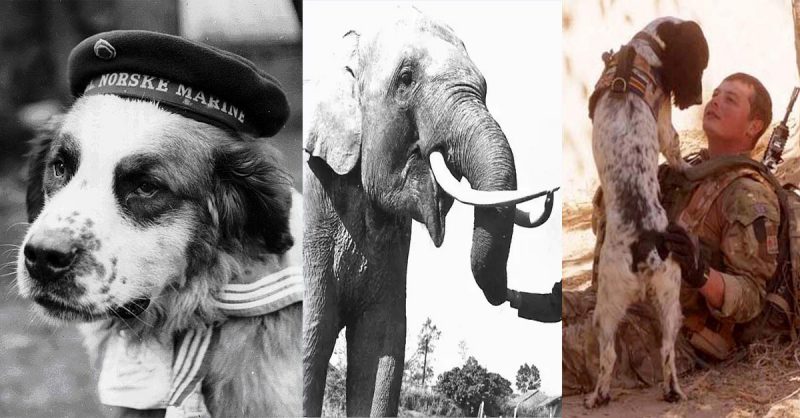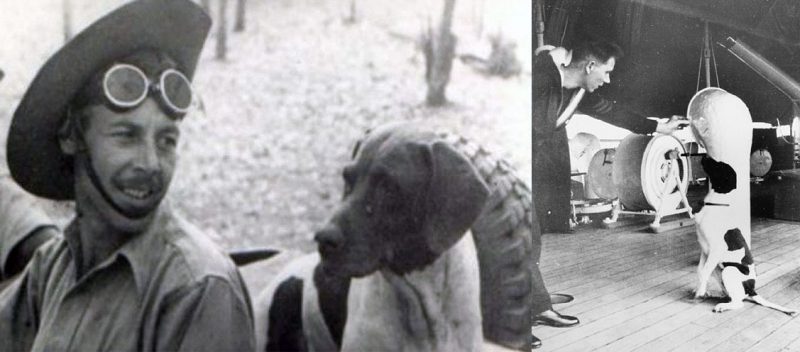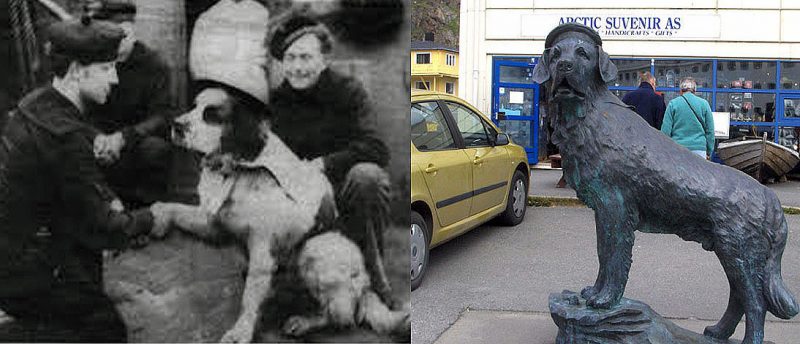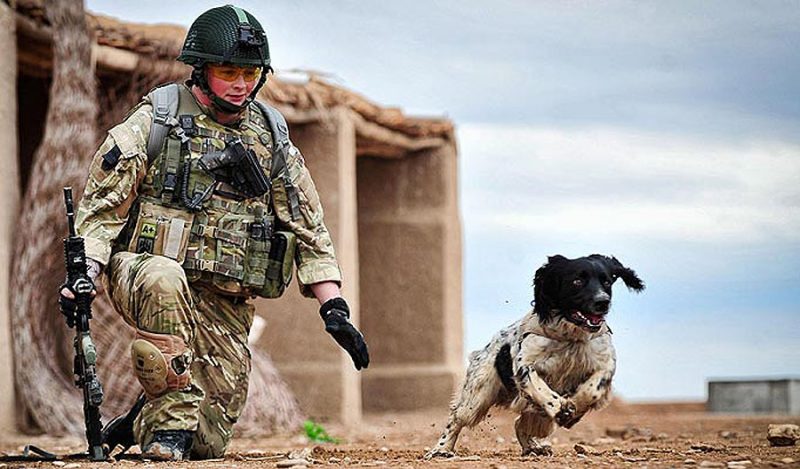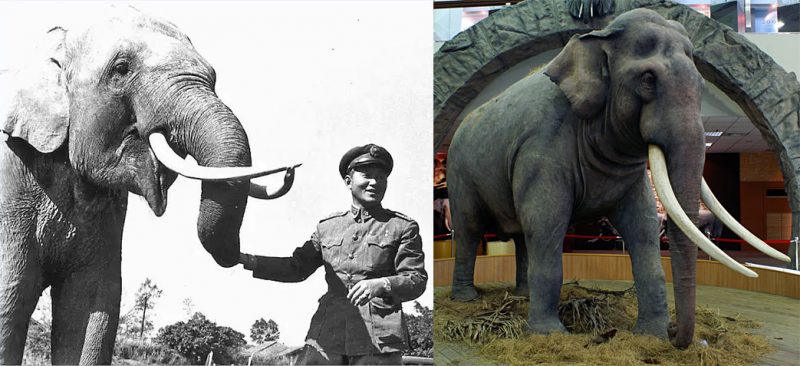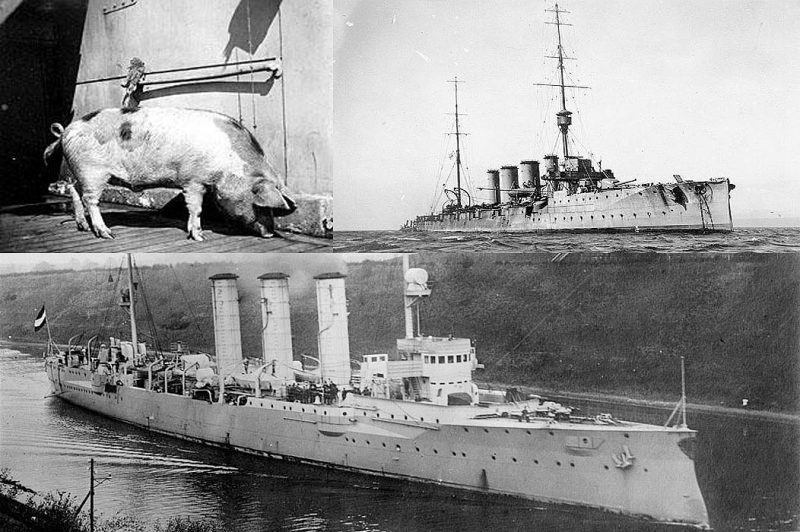Images Used (From left): (1) An iconic photograph of Bamse wearing a sailor’s cap of the Norwegian Navy during WWII (2) Lin Wang, the Asian elephant that served with the Chinese forces during the Second Sino-Japanese War (3) Theo and Tasker duo made 14 bomb finds in a term of 5 months in Afghanistan
Recognizing those who have risked their life and limb for their country is important. Description of a veteran isn’t just a description applicable to Homo sapiens only. Since the beginning of warfare, animals have been serving alongside humans in the warfare. Not only have some animals received distinctive honors for their services while being not part of the military but some amazing animals also officially served in the military. Popular blog of American magazine Mental Floss reported on 5 such amazing animals.
(1) Judy (1936 – February 17, 1950):
Judy was a pure bred liver and white pointer born in a dog kennel in Shanghai in 1936. The Captain and the Chief Bosun’s mate, Lieutenant commander J. Waldergrave and Chief Petty Officer Charles Jefferey of the Insect class gunboat of Royal Navy, HMS Gnat purchased Judy from that kennel and presented her to the crew. She became a mascot for Gnat in the autumn of 1936. A pet animal is maintained by different military units around the world solely for ceremonial purposes or as an abstract representation of that unit.
The researchers have suggested that animal behavior could be incorporated into earthquake forecasting. Many animals possess special senses like the earthquake related behavior. Dogs have robust sense of smell. They also do have a hearing range of 40 Hz to 60,000 Hz. Human hearing range is 20 Hz to 20,000 Hz. That means dogs can detect sounds far beyond the upper limit of auditory spectrum of the humans. No wonder, that Judy was known for pointing out the approach of Japanese aircraft long before any human crew could hear them. Prior to the outbreak of war, Judy’s ability to spot airplanes earlier was noticed. She would keep barking when any aircraft would fly low over the Gnat.
During an outing to Jiujiang, Petty officer Jefferey took Judy for a walk outside the city. And Judy was pulling Jefferey away from a spot; he looked back and found that it was a Leopard that Judy was pulling him away from. Part of the crew of Gnat including Judy was transferred to the dragonfly-class river gunboat HMS Grasshopper in 1939. During the outbreak of WWII in 1939, Grasshopper and other gunboats were deployed at the British base in Singapore; and along the coasts of Malaya in 1942 for covering retreating troops there and carrying out evacuations.
On February 13, the vessels were ordered to leave Singapore upon evacuating personnel. The ships were heading for Singkep Island in the Dutch East Indies, when Judy indicated the approach of the Japanese aircraft. And anti aircraft gunners took position accordingly. But Grasshopper was attacked and hit with three bombs before the airstrike was over. Fire spread near the ammunition compartment while the Japanese aircraft strafed the vessel. The ship was over a hundred yards away from shore. At that time, the crew had been ordered to abandon the ship and they went to shore of an island in small boats. Judy was in below decks and the crew had no time to rescue her.
The island was found to be uninhabited. It had little food and no apparent source of water. Petty officer George white was sent back to Grasshopper, which was still floating, to scavenge supplies. Upon entering the lower deck, he found Judy trapped under a row of lockers. He rescued her and returned back to the Island with some necessary materials along with Judy. Within a day or two, the situation was becoming dire without water. Just then, Judy started to dig at a point on the coastline and uncovered a fresh water spring. She was credited with saving the lives of the shipwrecked crew.
After 5 days, they were rescued and taken to Singkep, an Indonesian Island, by a type of light wooden boat called Tongkang. They left their wounded there. After couple of days, Judy, along with other survivors, travelled to Sumatra on a junk, a Chinese ancient sailing ship. There, it was hoped that they could travel to Sri Lanka with a remaining British force. Their vessel got stuck in the narrow river system and they were compelled to embark on a 200 mile cross-country trek across the island of Sumatra to Padang, a city in its western coast. During this trip, Judy was attacked by a crocodile that left a cut mark on her shoulder. They arrived at Padang after 5 weeks but missed the last ship that took part in evacuation process as a Japanese takeover of the city was imminent. The Japanese arrived and took the crew including Judy into custody as prisoners of war. They were sent to the POW camp in Medan in Northern Sumatra. This made Judy the only dog that was registered as a prisoner of war during the Second World War.
Leading Aircraftman (LAC) Frank Williams adopted Judy at the camp. He used to get small daily ration of rice and shared it with the dog from August 1942 onwards. Judy would distract the prison guards while they were carrying out punishments. She often growled and barked at the guards. Williams saved the dog from the prison guards, who would sometimes threaten to shoot Judy. Williams saved life of Judy by promising the Commandant of the POW camp one of Judy’s future puppies.
Judy would also alert the prisoners about any approaching Japanese guards, snakes, scorpions or other animals. In 1944, the prisoners were transferred to Singapore aboard a ship; but dogs were not allowed on board. Williams taught Judy to stay still and silent for a long time inside a rice sack. During boarding the ship, he took Judy in a sack and slung the bag on his back. The prisoners were forced to remain standing on the deck of the ship in the searing heat for over three hours and Judy remained silent for the entire time. The ship was cramped with over 700 prisoners. It was torpedoed on June 26, 1944. Williams pushed Judy out of a porthole to save her life; it was a 15 feet drop to the sea.
Williams also made his own escape from the torpedoed ship. But over five hundred of the prisoners did not survive. Williams was recaptured and he was sent to a new prison camp. There he heard the stories of a dog that had helped rescue many drowning men with pieces of floating debris to hold on. He was hoping to find Judy at the new camp and soon was knocked over on the ground by an ecstatic dog; it was Judy! They were transferred to Sumatra again by a paddle steamer to cut through the jungle to lay railway track. She also saved the lives of the railway workers there by alerting them to large animals like elephants or tigers. The Japanese soldiers eventually sentenced Judy to death but she managed to hide out in the Jungle for two days until the Allies arrived.
After the war, Judy and Williams returned to the United Kingdom on April 29, 1946. Frank Williams was awarded the PDSA White Cross of St Giles and Judy was awarded the PDSA Dickin Medal. PDSA or People’s Dispensary for Sick Animals is a veterinary charity in the United Kingdom.
Images Used: (1) Judy and Williams; Judy met LAC Frank Williams in a POW camp in Medan in Northern Sumatra in 1942. (2) Judy sits up on the deck of river gunboat HMS Grasshopper and listens to the commands of a sailor during WWII
(2) Bamse (1937 to July 22 1944):
Bamse was a St Bernard that eventually became a mascot of the Free Norwegian Forces during WWII. St Bernard is very large working dog originated from northern Italy and Swiss Alps. St Bernards were originally bred for rescue operations in the alpine region. The name Bamse is the Norwegian for ‘teddy bear’.
Erling Hafto, captain of Norwegian whale catching ship Thorodd bought Bamse in Oslo in 1937 in order to turn him into a ship’s dog. He is remembered as a very kind dog that would even look after the kids while they were playing. Hafto’s ship was drafted into the Norwegian Navy to be used as a coastal patrol vessel when WWII broke out and Bamse was officially enlisted as a member of the crew on February 9, 1940. Two months later, Nazi Germany invaded Norway. Before the surrender of mainland Norway on June 10, 1940, 13 Norwegian naval vessels including Thorodd managed to escape to the UK; arrived on June 17, 1940.
The vessel was converted into a minesweeper and stationed in Montrose & Dundee in Scotland for the remaining portion of the WWII. Bamse became well known to the local civilian population, he lifted the morale of the entire crew of the ship. During the battle, he would stand on the front gun tower of the vessel wearing a special metal helmet made by the crew for him. Heroic acts by Bamse include saving a lieutenant commander who had been attacked with a knife by a man. Bamse pushed the attacker into the sea. On another occasion, he also saved a sailor who had fallen overboard by dragging him back to shore.
Surprisingly enough, he was also known for breaking up fights among the crew by putting his paws on their shoulders. One of Bamse’s official tasks was to round up the crew at the end of the day to lead them back on the ship during the time of normal duty or curfew. To accomplish this task, the crew bought Bamse a bus pass and it was attached to his collar. He rode the bus from a bus stop called Broughty Ferry Road and would get off at the stoppage near the favorite bar of his crew. He would go in and fetch them. Or he would ride the bus back to base alone in case he couldn’t find them.
Soon, Bamse became the mascot of the Royal Norwegian Navy from being just one ship’s mascot. Later he became the mascot of the entire Free Norwegian Forces. An iconic photograph of Bamse wearing a sailor’s cap of the Norwegian Navy was appeared on patriotic Easter greeting cards and Christmas cards during the WWII. He was even made an official mascot for the Allied Forces by PDSA.
Bamse died due to heart failure at Montrose on July 22, 1944. He received full military burial and hundreds of people attended his funeral. For his war services, he was posthumously awarded the Norges Hundeorden on September 30, 1984. PDSA awarded him Gold Medal in 2006 for his devotion to duty; making Bamse the only animal from WWII to be honored in such manner. A slightly larger than life-size bronze statue of Bamse was erected on a street in Montrose in 2006. A biography of Bamse titled ‘Sea Dog Bamse’ was published in 2008.
Images Used: (1) Bamse would stand on the front gun tower of Thorodd wearing a special metal helmet made by the crew during WWII (2) A bronze statue of Bamse in Montrose
Video Used: A mini documentary on Bamse
(3) Theo (May 2009 to March 1, 2011):
Theo was an English Springer Spaniel who served as a bomb detection dog in the 1st Military Working Dog Regiment of the British Army while assigned in Afghanistan. English Springer Spaniel is a medium sized compact dog which is a breed of gun dog used for retrieving or flushing game. He was born in May 2009, trained in his duties and then assigned to his handler Lance Corporal Liam Tasker in 2010. The first two dogs which were assigned to Tasker didn’t work.
Tasker and Theo were posted to the Afghanistan in September 2010; it was Theo’s first assignment. They came under heavy fire from Taliban insurgents while patrolling with the 1st Irish Guards in the Nahri Saraj District in Helmand Province, Southern Afghanistan on March 1, 2011. A sniper killed Tasker. The fellow soldiers took Theo back to base. But after reaching the base, the young dog suffered a seizure and died. The death is thought to be caused by the stress he received from the attack and Tasker’s death. During the war in Iraq and Afghanistan, Theo was the 6th British military dog to die in Afghanistan.
Tasker and Theo duo made 14 bomb finds in a term of 5 months; more than any other team there. Because of their success, Theo’s stay in Afghanistan was extended by a month. Bodies of the dynamic duo were repatriated to the United Kingdom. PDSA posthumously awarded Dickin Medal to Theo on October 25, 2012.
Image Used: Theo and Tasker duo made 14 bomb finds in a term of 5 months in Afghanistan; more than any other team there
Video Used: Theo and Tasker filmed in Afghanistan in February 2011
(4) Lin Wang (January 18, 1917 to February 26, 2003):
Lin Wang was an Asian Elephant. He served in the Chinese Expeditionary Force during the Second Sino Japanese War and WWII. He lived most of his life in the Taipei Zoo in Taiwan and was affectionately called ‘Grandpa Lin Wang’ by children and even adults.
After the Japanese attack on Pearl Harbor in 1941, the Sino-Japanese war (1937-1945) became a part of the WWII. After the Japanese attack on the British colonies in Burma (now Myanmar), Chinese Expeditionary forces were formed by Generalissimo (highest military rank used in some countries, superior to field marshal) Chiang Kai-shek under General Sun Li-jen to fight against Japanese invasion in Burma. General Li-jen was known as the Rommel of the East.
Lin Wang the bull elephant initially served the Japanese forces by pulling artillery pieces and carrying supplies for them. He was captured along with twelve other elephants by the Chinese forces after a campaign at a Japanese camp in 1943. The allied forces used the captured elephants for the same purposes. Lin Wang was initially named ‘Ah Mei’ or ‘the beautiful’ by the Chinese army men.
The Expeditionary force was withdrawn back to China in 1945. They marched through the Burma Road that linked Burma with southwest China. Six elephants died during the challenging trek. The WWII ended by the time they reached Guangdong on the South China Sea coast. Their services to the army continued in the after war era. Ling Wang and other elephants helped the military erect some war memorials and monuments and performed for a circus in the summer of 1946 to raise fund for famine relief in Hunan province in South Central China.
Later four elephants in the group were sent to four separate zoos. Lin Wang and two other elephants were transferred to a park in Guangzhou province in South China. General Sun Li-jen was transferred to Taiwan to train some new troops in 1947. He took three elephants with him, one of which died during the trip. Lin Wang was among the two surviving elephants that reached Kaohsiung in Taiwan where he transported logs and some other simple works. By 1951, he was the only surviving elephant of the original thirteen elephants from Burma.
Lin Wang was handed over to Taipei Zoo in 1952 where he found his lifelong mater Malan. The zookeeper changed his name from ‘Ah Mei’ to ‘Lin Wang’ which is the shortened form of ‘King of the Forest’. His birthday was celebrated at the zoo every year since his 66th Birthday in 1983. He died on February 26, 2003 at the age of 86. Average life expectancy of an Asian elephant is 70. He is the longest living elephant in captivity. Lin Wang was a major celebrity in Taipei and his memorial services lasted for several weeks where several thousand people attended. He was posthumously awarded the ‘Honorary Taipei Citizen’ by mayor of the city. Taipei Zoo contains his life-size specimen made in 2004.
Images Used (From left): (1) Lin Wang, the Asian elephant that served with the Chinese forces during the Second Sino-Japanese War, with General Sun Li-jen in 1947 (2) Life-size specimen of the Asian elephant Lin Wang in Taipei Zoo.
(5) Tirpitz (during WWI):
Tirpitz was a pig kept as a source of fresh meat by the German Navy during the WWI. The British navy captured him from German light cruiser SMS Dresden during a naval combat following the Battle of the Falkland Islands in the South Atlantic. British Naval forces achieved a decisive victory in that battle on December 8, 1914. But Dresden was faster and managed to escape.
British light cruiser HMS Glasgow and HMS Kent located her near Chilean Island Mas a Tierra (now Robinson Crusoe Island) in the South Pacific on March 15, 1915. The Germans scuttled their own ship to prevent it to be captured by their enemy. But Tirpitz was abandoned on board as she sank. He made his way above the deck and was able to swim clear of the sinking ship. Tirpitz swam straight towards the nearby Royal Navy ship and a petty officer aboard Glasgow spotted him after an hour. He was rescued and adopted by the crew who made him the mascot of the ship.
He was subsequently named Tirpitz after Alfred von Tirpitz, the German Admiral and Secretary of State of the Imperial Naval Office. Tirpitz remained on the ship for a year and afterwards, was placed in quarantine for some time. The petty officer who rescued him was then allowed to adopt him. For the rest of his career, Tirpitz was transferred to Whale Island, Gunnery School in Portsmouth, England.
After the WWI, he was eventually auctioned off as pork in 1919. It was a charity auction through which the British Red Cross raised £1,785. Afterwards, his stuffed head was donated to the Imperial War Museum in England.
Images Used (Clockwise from top left): (1) Tirpitz aboard British light cruiser HMS Glasgow (2) HMS Glasgow, second home of Tirpitz (3) German light cruiser SMS Dresden
